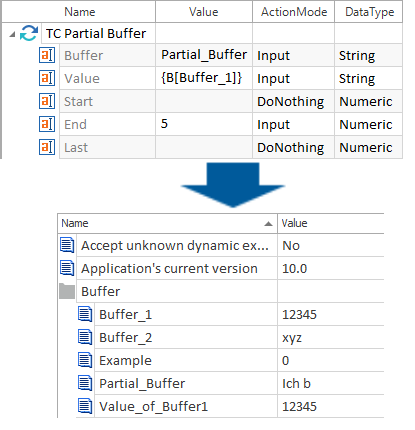Values can be stored in a global, variable buffer and collected from any position of the test execution (
Existing buffer values are displayed in the Settings dialog (
The package Buffer Operations contains the following Modules:
-
TC Set Buffer
-
TC Name To Buffer
-
TC Multi Buffer
-
TC Partial Buffer
-
TC Delete Buffer
TC Set Buffer
This Module serves to create and verify buffer values.
The Module TC Set Buffer contains the following attributes:
|
ModuleAttribute |
Description |
|---|---|
|
Buffer |
Name of the buffer. |
|
Value |
Value to be written to the buffer or value to be verified with the buffer's content. |
Depending on the ActionMode, you can specify whether the value in the field Value is to be entered or verified.
Example 1

|
The value Test is written to the buffer BufferName. The ActionMode must be set to Input .
TC Set Buffer - example 1 |
Example 2

|
The system verifies whether the buffer Existing Buffer contains the value Comparative Value. The ActionMode must be set to Verify .
TC Set Buffer - example 2 |
TC Name To Buffer
This Module writes the name of the TestCase using the Module to the specified buffer.
The Module contains the following ModuleAttribute:
|
ModuleAttribute |
Description |
|---|---|
|
Buffer |
Specifies the name of the buffer, which should be used to save the TestCase name. If the specified buffer name does not exist yet, it will be newly created. |

|
TC Name To Buffer TestCases must be run via ExecutionLists in the Execution section. The ScratchBook cannot be used, because this would produce different results. |

|
In the example below, the name of the TestCase TestCase01 is entered as value of the buffer TestCase name. The ActionMode must be set to Input .
TC Name To Buffer |
TC Multi Buffer
This Module allows any values to be assigned to several buffer variables within one TestStep.
The Module Multi Buffer contains the following attribute:
|
ModuleAttribute |
Description |
|---|---|
|
Buffer |
The buffer name and the value are entered into the Value column. Syntax:<Buffername>=<Value> If only the value is specified, the name of the TestStepValue is used as buffer name. If the specified buffer name does not exist, it will be newly created. |

|
In the example below, four buffers are specified with the following values:
For further information on how existing buffer values are used, please refer to chapter "ActionMode Buffer".
TC Multi Buffer |
TC Partial Buffer
This Module allows parts of a value to be either written to a buffer variable or to be verified.
The Module Partial Buffer contains the following ModuleAttributes:
|
ModuleAttribute |
Description |
|---|---|
|
Buffer |
Name of the buffer. |
|
Value |
Value to be either written to the buffer or to be verified. |
|
Start |
Index of the character to be used as starting point for the value to be either copied to the buffer or verified. |
|
End |
Index of the character to be used as endpoint for the value to be either copied to the buffer or verified. |
|
Last |
Number of characters to be either copied to the buffer or verified, starting from the end. If this value is specified, the ModuleAttributes Start and End are ignored. |
If only the values Buffer and Value are specified, the functionality is similar to the Module TC Set Buffer.

|
The buffer Buffer_1 has the value Ich bin ein Beispieltext. This value up to and including the fifth character should be written to the buffer Partial_Buffer. The ActionMode must be set to Input . The buffer Partial_Buffer including the value ich b is created in the Settings dialog of Tosca Commander™.
TC Multi Buffer |
TC Delete Buffer
This Module deletes the content of all existing buffers from the Settings.xml file. All existing buffer variables are maintained.
The TestStep is executed without any specified values or ActionModes.

TC Delete Buffer




